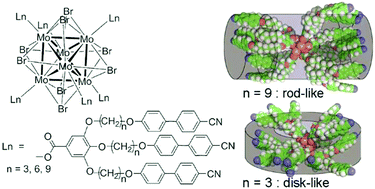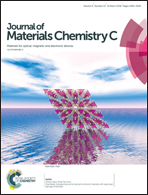Tailoring the self-assembling abilities of functional hybrid nanomaterials: from rod-like to disk-like clustomesogens based on a luminescent {Mo6Br8}4+ inorganic cluster core†
Abstract
Self-organizing processes are elegant ways to generate and control the nanostructuration of hybrid materials. We describe in this work the synthesis, self-organizing abilities and photo-physical properties of (nBu4N)2[Mo6Bri8(L)a6] clustomesogens containing 18 cyanobiphenyl (CB) mesogenic moieties spread equally around the metallic scaffold via aliphatic spacers. By controlling the spacer length and thus the mesogenic density around the rigid inorganic bulky scaffold, we tailored the morphology of hybrid supermolecular building blocks from rod-like to disk-like which strongly influenced their self-organizing abilities. The photophysical properties of hybrids were investigated in their glassy state and in solution. Temperature studies reveal different behaviours depending on the hybrid nanostructuration. Despite their isotropic nature, octahedral clusters offer numerous possibilities in the design of self-assembled hybrid materials showing strong luminescence properties, which is of particular interest in the fields of optics or optoelectronics.



 Please wait while we load your content...
Please wait while we load your content...